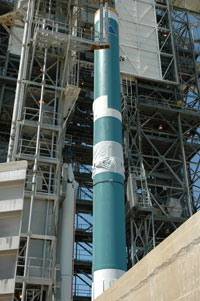
Handy Links
SLAC News Center
SLAC Today
- Subscribe
- Archives: Feb 2006-May 20, 2011
- Archives: May 23, 2011 and later
- Submit Feedback or Story Ideas
- About SLAC Today
SLAC News
Lab News
- Interactions
- Lightsources.org
- ILC NewsLine
- Int'l Science Grid This Week
- Fermilab Today
- Berkeley Lab News
- @brookhaven TODAY
- DOE Pulse
- CERN Courier
- DESY inForm
- US / LHC
SLAC Links
- Emergency
- Safety
- Policy Repository
- Site Entry Form

- Site Maps
- M & O Review
- Computing Status & Calendar
- SLAC Colloquium
- SLACspeak
- SLACspace
- SLAC Logo
- Café Menu
- Flea Market
- Web E-mail
- Marguerite Shuttle
- Discount Commuter Passes
-
Award Reporting Form
- SPIRES
- SciDoc
- Activity Groups
- Library
Stanford
Around the Bay
Delta II Rocket Coming Together for GLAST Satellite Launch
 The Delta II 7920-H, or "Heavy," rocket that will launch the Gamma-ray Large Area Telescope (GLAST) satellite is in the process of being assembled on Launch Pad 17-B at Cape Canaveral Air Force Station, Florida.
The Delta II 7920-H, or "Heavy," rocket that will launch the Gamma-ray Large Area Telescope (GLAST) satellite is in the process of being assembled on Launch Pad 17-B at Cape Canaveral Air Force Station, Florida.
Solid rocket boosters were recently attached to the rocket. A series of nine strap-on solid rocket motors will next be mated with the rocket to help power the first stage. Because the Delta rocket is configured as a Delta II 7920 Heavy, the boosters are larger than those used on the standard configuration.
"The Delta II is one of our most reliable launch vehicles," said Rick Harnden, GLAST Program Scientist at NASA Headquarters, Washington. "However, we'll be breathing a lot easier once GLAST has been lofted successfully into orbit."
GLAST is slated for launch from the Cape Canaveral Air Station on May 16 between 8:45 a.m.–10:40 p.m. PDT. GLAST's main instrument, the Large Area Telescope (LAT), was integrated at SLAC in 2005 and 2006 from hardware fabricated at laboratories all around the world.
GLAST is a powerful space observatory that will explore the most extreme environments in the Universe, where nature harnesses energies far beyond anything possible on Earth. It will search for signs of new laws of physics and what composes the mysterious dark matter, explain how black holes accelerate immense jets of material to nearly light speed, and help crack the mysteries of the stupendously powerful explosions known as gamma-ray bursts.
The GLAST spacecraft is 9.2 feet high by 8.2 feet in diameter when stowed in the rocket, where it is just under the 9-foot diameter allowed in the fairing. GLAST becomes a little bit taller and much wider after it is launched into space, when the Ku-band antenna deploys and the solar arrays are extended.
NASA’s GLAST mission is an astrophysics and particle physics partnership, developed in collaboration with the U.S. Department of Energy, along with important contributions from academic institutions and partners in France, Germany, Italy, Japan, Sweden, and the United States.
—NASA, republished in SLAC Today, April 17, 2008
The original NASA web feature can be
found online.
Above image: On Pad 17-B, the mobile service tower (left) approaches the Delta II rocket (right). The solid rocket boosters in the tower will be mated with the rocket. (Photo courtesy of NASA/Jim Grossmann.)